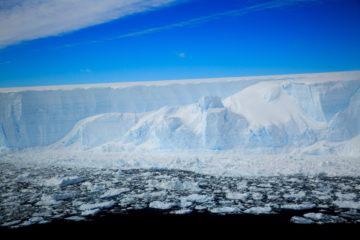May 20 2021
Scientists have used geological records to rebuild, for the first time, the history of the Larsen C Ice Shelf situated in Antarctica.
 Larsen C Ice Shelf on the Antarctic Peninsula. Image Credit: Ali Rose.
Larsen C Ice Shelf on the Antarctic Peninsula. Image Credit: Ali Rose.
The ice shelf is considered to be the biggest leftover remnant of a much wider area of ice on the Antarctic Peninsula that started to break up in the 1990s (Larsen A) and experienced an enormous collapse in 2002 (Larsen B).
This new rebuilding allows researchers to better comprehend whether and when the leftover ice shelf could fall in the future.
In the study published in the journal Geology on May 2021, an international research group explains how the biggest remaining ice shelf on the Antarctic Peninsula has been steady for the past ~1000 decades.
The immense Larsen Ice Shelf, which is twice the size of Wales, gained worldwide media attention following the calving of a 5,800 km2 iceberg weighing over a trillion tons in 2017. In April 2021, the shelf entirely broke up, after a three-year journey drifting from the Antarctic Peninsula to the sub-Antarctic island of South Georgia.
In the last 25 years, many of the region’s ice shelves have crashed, such as the quick destruction of the Larsen B Ice Shelf in 2002. The ice shelves’ consecutive break up along the eastern Antarctic Peninsula is related to warmer atmospheric temperatures, which have slowly shifted southward in the last five decades. Simultaneously, there has been an increase in warm ocean currents, which have weakened the region’s ice shelves from below.
By employing hot-water drilling technology to penetrate via the 300-m-thick ice shelf, the researchers gathered seabed sediment cores from below the Larsen C Ice Shelf in 2011.
Data obtained from these cores were integrated with data from sediment cores recovered offshore 10 years earlier, thereby allowing the science group to rebuild the first elaborate history of the ice shelf. The researchers arrived at a conclusion that in spite of the modest retreat and progress of the ice shelf front, there was no considerable breakup in the last 1000 decades.
There is a huge international scientific effort underway to get a better understanding of what’s happening to Antarctica’s ice shelves. If we can understand what happened in the past we will have a sense of what might happen in the future.
Dr James Smith, Study Lead Author and Marine Geologist, British Antarctic Survey
“We can perhaps differentiate natural events that affect the ice shelves from environmental change related to human activity. This new study provides the final piece of the puzzle to the history of this largest remaining ice shelf on the eastern Peninsula,” added Smith
The researchers propose that the endurance of Larsen C, as well as Larsen B, denotes that such ice shelves stood stronger against past climate warming since they were thicker, or that the heat from the ocean and air did not penetrate this far south.
In this regard, the fall of Larsen B in 2002 offered the first hint that the scope of contemporary ice shelf break-ups was beginning to push further south compared to that in the past 1000 decades. Moreover, Larsen C is exhibiting signals that it may be the next ice shelf in line to fall.
We now have a much clearer picture of the pattern and extent of ice shelf break-ups, both past and present. It starts in the north and progresses southward as the atmosphere and ocean warms. Should collapse of Larsen C happen, it would confirm that the magnitudes of ice loss along the eastern Antarctic Peninsula and underlying climate change are unprecedented during the past 10,000 years.
Dr James Smith, Study Lead Author and Marine Geologist, British Antarctic Survey
Journal Reference:
Smith, J. A., et al. (2021) History of the Larsen C Ice Shelf reconstructed from sub-ice shelf and offshore sediments. Geology. doi.org/10.1130/G48503.1.